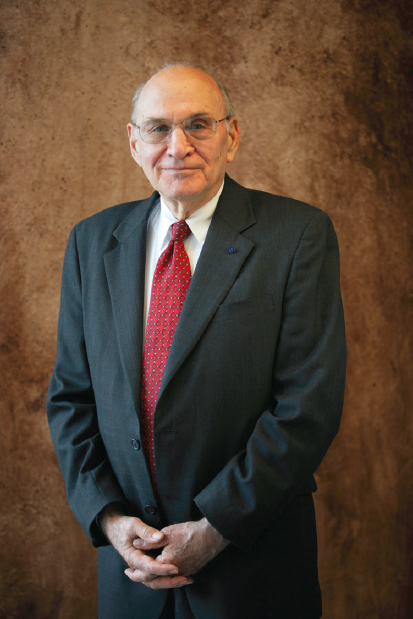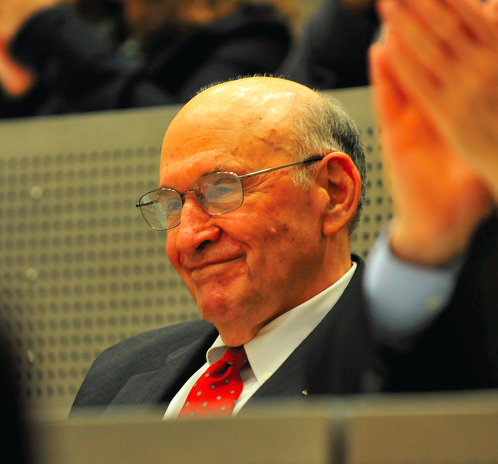

GEORGE E. DIETER
1928–2020
Elected in 1993
“For contributions to engineering education in the areas of materials design and processing.”
BY HOWARD KUHN AND JIM WILLIAMS
GEORGE ELLWOOD DIETER JR. was born in Philadelphia on December 5, 1928, and raised in Germantown. He enrolled at Drexel Institute of Technology (now Drexel University) in 1945 and received his BS in metallurgical engineering in 1950 (at this co-op school with a focus on serving the technical and operational needs of regional industries, 5 years is typically required for the BS degree). George’s academic accomplishments were highly regarded, so he was recommended for graduate study elsewhere as Drexel did not have a graduate program at that time.
He continued his studies in metallurgical engineering at the Carnegie Institute of Technology (CIT), from which he received his ScD in 1953. His thesis advisor was Robert F. Mehl who, as director of the Physical Metallurgy Laboratory at the Naval Research Laboratory (1928–31), had become highly regarded in defense circles for his development of gamma radiography as a method for evaluating large naval castings. As director of the Metals Research Laboratory (1932–35) and head of the Department of Metallurgy (1935–60) at CIT, Mehl played a strong role in establishing a science base for the study of metallurgy, introducing a fundamental approach to courses in phase transformations and mechanical behavior and promoting the use of advanced mathematical analysis in his students’ research.
Mehl was also a regular consultant for various companies, which later had an influence on George. He stressed the importance of applying basic science to understand metallurgical phenomena, but always with a focus on problems of industrial importance.
Against this backdrop and influence, George’s doctoral research focused on the statistical aspects of fatigue failure of steels, the importance of which was highlighted by numerous failures in defense and industrial equipment during the previous decades. His research, funded by the National Advisory Committee for Aeronautics (NACA), led to two NACA reports: Investigation of the Statistical Nature of Fatigue of Metals (NACA TN 3019, September 1953) and Statistical Study of Overstressing in Steel (NACA TN 3211, April 1954).
Upon completing his ScD degree, George fulfilled the military obligation resulting from his ROTC participation at Drexel at the US Army Laboratory at Aberdeen Proving Grounds (1953–55). After his military service as an officer, he worked as a research engineer and research supervisor at E.I. DuPont Engineering Research Laboratory, in Wilmington, Delaware.
His more influential activity during this period was writing the textbook Mechanical Metallurgy (McGraw-Hill, 1961). While mechanical metallurgy courses had been presented at many universities, there was not a unified or comprehensive curriculum for the subject. Mechanical Metallurgy filled that gap. One of us (JW) used this text in graduate school and found it to be very helpful and a tremendous consolidation of the literature in this area.
With perfect timing, Doc Grosvenor, longtime head of Drexel’s Metallurgy Department, retired in 1962 and Dieter was the obvious choice to fill the vacancy. As department head (1963–68) Professor Dieter assembled research-oriented faculty members and grew the research portfolio at an impressive pace. This new emphasis on research coincided with Drexel’s transition from a teaching institution to a research university, directed by the newly appointed president, William Hagerty, formerly dean of engineering at the University of Texas.
Through George’s drive and foresight, the Metallurgy Department was soon 20 years ahead of the other Drexel engineering departments in developing a productive research program. The department also broadened its focus beyond metals by adding faculty in ceramics and polymers to become a Materials Engineering Department.
Dieter was very active in recruiting top high school talent in the region to bolster the department’s reputation and upgrade its students’ admission credentials. Despite his stern approach to teaching and research, he had a heart of gold and took a personal approach to making incoming students as well as his new faculty feel more comfortable and welcome in their new surroundings. For example, George invited me (HK) and my wife to stay with his family while we looked for housing before our relocation to Philadelphia and he helped find a property that we rented for our move.
Diran Apelian wrote that “George Dieter was my teacher, mentor, and guardian angel of sorts. I was an immigrant to America having had two years of high school before entering Drexel in the metallurgical engineering department that Dieter headed. His support, inspiration, and encouragement were pivotal to my success as an undergraduate. He took me under his wing and encouraged me…and made me do things I did not think I could do.… He was an amazing individual—highly disciplined, visionary, with a superb strategic mind…. He was a leader who ensured that others were given opportunities to lead and who cared deeply about his colleagues, students, and staff. His disciplined stern façade was just that; he had a heart of gold and touched many of us.”
A humorous anecdote further testifies to the general recognition and appreciation of his nature. During holiday parties at Drexel the students would present parodies of the faculty. One of these depicted George being held up at the airport metal detector before boarding a flight—this actually had happened and the students got wind of it; recreating the incident, the students asked, “Was this caused by his will of iron, his heart of gold, or what?”
Professor Dieter also instituted a graduate course in design for materials engineers. This experience led him to refine the
course content of his book Engineering Design: A Materials and Processing Approach, which was even more widely used than Mechanical Metallurgy. His monumental effort revolutionized materials education by collecting results from a multitude of sources into a cohesive curriculum on design, filling a need in materials departments worldwide for the methods that convert engineering science and discoveries into useful products and successful enterprises.
As a reflection of Dieter’s grasp of the breadth of mechanical metallurgy, he hired one of us (HK)—a mechanical engineer with interests in materials—to expand the mathematical and design component of the evolving curriculum. He had learned of my interests in plasticity mechanics and metallurgy through his consulting work with TRW and DuPont, companies where I had interviewed for employment. When I joined the Drexel faculty in 1966, Dieter already had a project on high-temperature torsion testing sponsored by the Naval Research Laboratory, which provided a start for my research program. He also made connections for me with industrial and federal agencies, whose funding led to breakthrough theories of ductile fracture and plasticity of porous materials.
These results were a springboard to development and commercialization of the powder forging process under the powder metallurgy program. At the time the powder metallurgy industry was increasing in importance as a source of critical components for defense and aircraft, but the subject lacked a broad science base. One response to fill this need was a Defense Department program called Themis that addressed the spectrum of powder metallurgy processes from powder making to high-density forming to economics. Dieter, together with Richard Heckel (recruited to Drexel from DuPont), wrote a successful proposal that launched Drexel to an eventual leadership position in the powder metallurgy industry, a role that continues. Alan Lawley, an expert in scanning and transmission electron microscopy (SEM/TEM) and dislocation, was principal investigator of the Themis program, and faculty from other engineering departments were enlisted to cover the wide range of topics in powder metallurgy.
George Dieter’s success in growing the Materials Engineering Department at Drexel led to his promotion to dean of engineering in 1969. His attempt to reorganize the School of Engineering into a matrix of departmental capabilities and individual research interests, aimed at promoting interdisciplinary collaboration to create appeal to a broader range of research opportunities, was ahead of its time and was unsuccessful due to divergent faculty interests.
In 1973 he returned to CIT, now Carnegie Mellon University (CMU), to serve as director of the Processing Research Institute. In meetings with potential industry sponsors Dieter displayed his clear vision for linking fundamental research to industrial needs. His no-nonsense approach was apparent in his preference to quickly and efficiently get to the heart of a meeting agenda and his impatience with industrial protocol.
One of us (JW) joined the faculty of the CMU Materials Department in 1975, coming from over 15 years in the aerospace industry. George was wonderfully supportive of new faculty members as we worked to establish our research groups and settle in to new, unfamiliar roles. George willingly and unobtrusively provided tremendous help. I remain grateful to him.
Dieter longed to return to the excitement and challenge of an educational leadership role, and in 1977 he gladly accepted appointment as dean of the Clark School of Engineering at the University of Maryland. He held this position until his retirement in 1994, and then continued to play an active role in the school nearly until his death.
He was active in the broader community as well. He chaired the Engineering Deans Council and served as president of the American Society for Engineering Education (ASEE). He was appointed to a number of committees of the National Academies of Sciences, Engineering, and Medicine, including the Committee on Assessing Corrosion Education (2007–08), the Army Research Laboratory Technical Assessment Board (2001–04) and its Panel on Armor and Armaments (2001–02; chair, 2002–04), the Committee on Materials Science and Engineering: Forging Stronger Links to Users (1997–99),
Workshop Committee on Structural Materials Research Advancements (chair, 1997–98), Committee on Assessment of Research Needs for Wind Turbine Rotor Materials Technology (chair, 1989–91), and National Materials and Manufacturing Board (1979–81).
His contributions were recognized by the SME Education Awad (1987), election to the NAE (1993), the TMS Educator Award (1994), and ASEE’s highest award, the Lamme Medal (1996).
He spent more time at UMD than anywhere else, and his influence was—and still is—felt in every corner of the university. He made competition a priority and encouraged students to participate in national engineering competitions. He launched the Maryland Technology Enterprise Institute, invited distinguished alumni to keep the Clark School’s classes and programming at the leading edge, established a Capstone Design Fund, and supported a professorship named in his honor. As a tribute to their daughter Barbara June Dieter (1958–88), he and his wife, Nancy, established a merit-based scholarship for a mechanical engineering student in the Women in Engineering Program.
On December 5, 2018, the occasion of George’s 90th birthday, a ceremony was held at UMD to honor him with the dedication of the George E. Dieter Jr. Materials Instructional Laboratory.
George died December 12, 2020, at age 92. Nancy (née Russell), his wife of 67 years, predeceased him on January 16, 2020. They are survived by their daughter Carol Joan Dieter.








